 Letter Home from the Holy Land
Letter Home from the Holy Land
May 3, 1988
Dear Grandma and Grandpa,
I've been wanting to sit down and write you a "real" letter for quite a while. We're thoroughly enjoying our time in Israel.
We got back from Egypt last Tuesday on a bus that left Cairo at 4:30 a.m. At the border, we were greeted profusely by the mayor of Miami Beach, Florida, dressed in Israeli army garb. He had a photographer in tow who aimed at us once or twice but I ducked behind the seats. We never did learn what was going on.
We got to Jerusalem and had our first trouble with buses. We waited and waited for a bus to the central bus station and when it finally arrived, hoards of people crowded on, pushing their way past us as we tried to board with our packs. Just after I stepped on, the driver decided he had enough passengers. He shut the door and pulled away, leaving Dennis behind! I begged him to stop and let me out, and fortunately, he complied. We pushed our way on first when the next bus finally arrived.
Our Youth Hostel book said we could take bus 4, 7, 9, 15 or 22 from the Central Bus Station (which seemed to be anything but central). We waited and waited for bus 9 (each bus has a separate stop). As I perused the map, I had a growing sense that we should be on the other side of the street. We couldn't find anyone with information, but I was so sure of it that we went to the other side and looked for a sign with any of the right numbers. We walked until the road went down a hill and there were no more bus stops in sight. "Well," I thought, "maybe the bus goes around the block and back towards town."
So we crossed back over and waited and waited for bus 7. Finally one arrived. I boarded and asked if it went to the hostel. The driver yelled at me at the top of his voice, "Other side of the street, lady." I asked, "Where on the other side of the street?" He just motioned and kept yelling, "Other side of the street, other side of the street. I've just come from there." He closed the door before I was halfway out.
We looked up and down the other side of the street again without luck. We tried to call the hostel with no luck and finally decided to try walking. A kilometer or so down the road we finally found a stop (on the other side of the street, of course) and boarded the bus.
I asked the driver if he went to the hostel and he said yes. But we didn't know where to get off, so we went a mile past it (most drivers had been very good about informing us when they reached our stop). We had to walk back carrying the backpacks. On the way, we passed a car rental firm advertising a car for a week for only $110.00. We were by now convinced that buses were not the way to go. We rented the car.
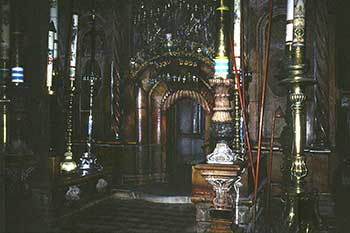 We spent the first two days in Jerusalem. We visited the Old City, which is surrounded by walls and has narrow winding cobblestone streets with hundreds of tiny shops and stands. We found the Church of the Holy Sepulcher, which according to Catholic and Orthodox tradition is the site of Christ's crucifixion and burial.
We spent the first two days in Jerusalem. We visited the Old City, which is surrounded by walls and has narrow winding cobblestone streets with hundreds of tiny shops and stands. We found the Church of the Holy Sepulcher, which according to Catholic and Orthodox tradition is the site of Christ's crucifixion and burial.
Throughout history, there have been bitter battles about which Christian sect should control the "holy places of Christendom." The Church of the Holy Sepulcher is divided into rigidly defined areas which are cleaned and controlled by various sects. Even in modern times, the Israeli government is sometimes asked to intervene to settle disputes.
The Protestants stayed out of the fray and have their own tomb and possible site of the Crucifixion called the "Garden Tomb." It's privately owned and is about 2000 years old. It is probably not Jesus' tomb, but it sure looks more like what I'd imagined than the Holy Sepulcher. The Garden Tomb is in a beautiful, peaceful area (if you can ignore the tourists). A man from England led us on a free tour, telling us the history of the place and how people came to think in the late 1800s that it could be Jesus' tomb. Archaeologists dispute it, but regardless, it's a beautiful place.
As far as tourists, they haven't been much of a problem. Tourism is down because of all the tension and media coverage. Also, high season isn't until hot July. Right now it's lovely and cool, an excellent time to visit.
After the Garden Tomb, we went back to the city walls and under the Old City into Zedekiah's cave, also known as Solomon's Quarry. Stone from this ancient underground quarry was used to build parts of Old Jerusalem.
Then we took a long walk to the Mount of Olives. The Garden of Gethsemane was closed for lunch, so we rested and then climbed to the top, to the Dome of the Ascension on the traditional site of Jesus' ascension into heaven.
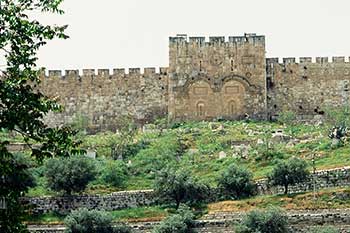 We had a beautiful view of the Old City on the way down, including the Golden Gate, through which Jesus is said to have entered Jerusalem in triumph (the walls have been rebuilt since). Jewish tradition says that it is through this gate that Messiah will enter the city. It was bricked up centuries ago by a Muslim leader, who wanted to prevent any would-be Messiah from entering and wresting control of the city from Muslims. It is said that the gate will not reopen until Judgment Day.
We had a beautiful view of the Old City on the way down, including the Golden Gate, through which Jesus is said to have entered Jerusalem in triumph (the walls have been rebuilt since). Jewish tradition says that it is through this gate that Messiah will enter the city. It was bricked up centuries ago by a Muslim leader, who wanted to prevent any would-be Messiah from entering and wresting control of the city from Muslims. It is said that the gate will not reopen until Judgment Day.
We then walked on around and through the Dung Gate (so called because it led to a dump in olden times) and to the Western Wall, the only remaining wall of the Second Temple and the holiest site for the Jews. People come there from all over the world to pray. They leave slips of paper with their prayers in the cracks of the wall.
The next day we took a bus to Yad Vasham, the Museum of the Holocaust. I'd seen a TV show about it. It was very interesting and moving. We stayed there a long time. The memorial to the children who died in the Holocaust was a totally dark underground room with a few candles burning, but reflected in a system of mirrors so as to appear as an infinite number of lights stretching away in all directions. The names and home countries of children who died were read out, one by one by one by one by one by one.
We then went to the Shrine of the Book, where the Dead Sea Scrolls are housed. The admission was $6.00 each, which seemed a bit steep. We were exhausted from the morning so found a peaceful place in a nearby park and took a wonderful nap. That's something I love about traveling on our own rather than with a group, no one to hurry us on.
The next day (Friday the 29th), we picked up the car, bought some groceries, and headed south, first to Bethlehem. The Church of the Nativity was rather like the Church of the Holy Sepulcher, dark and all stone. I guess I'd expected to see a manger or something. Dennis looked for the inn.
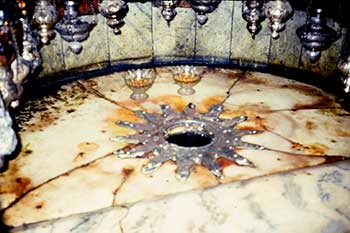 I wish they'd enforce a rule of silence and play quiet music in the background. It wasn't a very spiritual experience to jostle past the traditional site of the birth of Christ along with hundreds of tourists and a group of Greek Orthodox priests singing loudly and off key. I doubt if Christian groups could agree on what music to play and I suppose trying to keep a group of tourists quiet is like trying to keep a group of kids quiet. Still, it would be nice if they'd at least build a manger (I'm kidding).
I wish they'd enforce a rule of silence and play quiet music in the background. It wasn't a very spiritual experience to jostle past the traditional site of the birth of Christ along with hundreds of tourists and a group of Greek Orthodox priests singing loudly and off key. I doubt if Christian groups could agree on what music to play and I suppose trying to keep a group of tourists quiet is like trying to keep a group of kids quiet. Still, it would be nice if they'd at least build a manger (I'm kidding).
Bethlehem is in the occupied West Bank, and is predominantly Arab, so tourism is down dramatically. Normally, I suppose there would have been a thousand tourists and a two-hour wait. We tried to find Shepherd's Field, unsuccessfully. It was not hard to imagine shepherds on the rocky hillsides and a shining star in the east.
The rest of the day we spent driving south through the Negev Desert to Eilat, the southernmost city in Israel, on the Red Sea. We were able to camp there for free on the beach.
Saturday, the 30th, it rained. Only a few drops, but as everything we'd read and heard said it never rains in Eilat, it was an event. We visited Coral World, with an underwater observatory and a huge saltwater aquarium. I couldn't believe the colorful coral and brilliant tropical fish. There was also a shark tank and a turtle tank with huge turtles. I wish I could scuba dive. The Red Sea here has some of the best diving in the world. We spent the afternoon on the beach. The water was cold but not unbearable and the sun warmed us when we got chilled.
The next morning we visited Coral Reef Nature Preserve, where we rented fins, masks and snorkels. The water was freezing but we went in several times anyway, with warmups in between on the beach. We are finally starting to get tan! Some of the nicest things we saw snorkeling were brilliantly colored parrot fish eating coral, a moray eel, schools of goldfish, huge clams, and long skinny fish that looked like sticks.
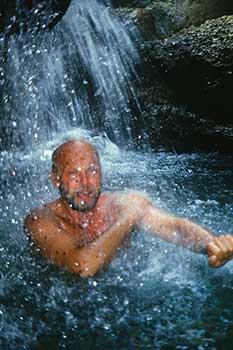 Then we drove north to En Gedi on the Dead Sea, where Dennis took a "swim" (more about that later). We camped near Masada, King Herod's desert fortress situated on a 1000-foot mesa. Early the next morning, we climbed up and reached the top by sunrise. It was impressive—huge storerooms, elegant palaces and a massive underground cistern. A group of Jewish rebels seized the fortress and held off the Romans for three years after the fall of Jerusalem in 70 A.D. Fifteen thousand Romans besieged the fortress, where 967 Jewish men, women and children were holed up. The siege camps and a wall all the way around the mesa can still be seen.
Then we drove north to En Gedi on the Dead Sea, where Dennis took a "swim" (more about that later). We camped near Masada, King Herod's desert fortress situated on a 1000-foot mesa. Early the next morning, we climbed up and reached the top by sunrise. It was impressive—huge storerooms, elegant palaces and a massive underground cistern. A group of Jewish rebels seized the fortress and held off the Romans for three years after the fall of Jerusalem in 70 A.D. Fifteen thousand Romans besieged the fortress, where 967 Jewish men, women and children were holed up. The siege camps and a wall all the way around the mesa can still be seen.
The Romans finally won by building an earthen ramp to the top. When they got there, however, they found all the possessions of the Jews burned and everyone dead. The Jews chose suicide over slavery and torture. "Long ago we resolved to serve neither the Romans nor anyone else but God," they wrote. "Let us die unenslaved by our enemies, and leave this world as free men."
These days, Israeli soldiers come to the top of this mesa to swear, "Masada shall not fall again." The West Bank and Jericho, hotbed of PLO activity, are just a few miles north.
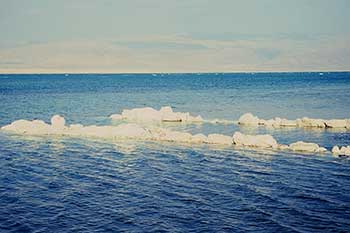 We went back to the Dead Sea and "swam." The Red Sea is quite salty so it was easy to float, but this was incredible! The surface of the lake is 1300 feet below sea level and the water contains 37% salt, compared to the Red Sea's 6%. We could almost "walk on water." When we stood straight up in deep water, we only sank to our chests. We watched a man try to dive under. Impossible! He practically bounced. You can lie on your back on top of the water and read a book!
We went back to the Dead Sea and "swam." The Red Sea is quite salty so it was easy to float, but this was incredible! The surface of the lake is 1300 feet below sea level and the water contains 37% salt, compared to the Red Sea's 6%. We could almost "walk on water." When we stood straight up in deep water, we only sank to our chests. We watched a man try to dive under. Impossible! He practically bounced. You can lie on your back on top of the water and read a book!
From there we climbed up David's Canyon to a beautiful waterfall. I jumped in to wash off the Dead Sea salt. We were lucky to get there between two huge school groups. When the second group arrived, we left and climbed up a steep path to the David Cave, where David hid from King Saul. We went swimming and took showers under a sparkling waterfall.
We drove on to Jericho, said to be the oldest city on earth. All shops and stores were closed in mid-afternoon. It is on the West Bank. Only a few people were out on the streets. It seemed like a ghost town. We arrived too late in the day to visit Tel Jericho, the archaeological remains of the old city, so we continued to Jerusalem to spend the night.
Next day, we visited the Citadel in Jerusalem, a castle built right into the city walls. Then Al-Aqsa Mosque and the Dome of the Rock, built over the huge rock (58 feet north to south, 44 feet east to west, 5 feet high) where Abraham prepared to sacrifice Isaac and from which Mohammed is said to have ascended to heaven. This is on the site of the destroyed Second Temple. The Muslims feared that when the Jews captured Jerusalem in June 1967, their buildings would be destroyed and the Temple rebuilt. The Israeli government, however, has committed to protect and respect the holy places of all religions.
We drove north again through occupied territory, with army jeeps and soldiers everywhere, to Megiddo (Har Megiddo or Armageddon), the remains of the ancient city which overlooks the plains of Megiddo, the battlefield for the final war according to Bible prophecy. We visited the tel (a pile of ruins gradually being excavated) and walked through an underground tunnel to the spring which had been outside the city walls. King Ahab built the tunnel to conceal and protect the city's water source in times of siege.
Then to Nazareth, but it was too late to see anything. Although it is not in West Bank territory, it is inhabited primarily by Arabs. We decided to return later. We drove on through Cana, site of Jesus' first miracle, to Tiberius on the Sea of Galilee. The "sea" is actually a large, freshwater lake. You can see the whole Sea of Galilee at one time from hills overlooking it.
We found a campground and set up our tent near a low seawall. It was so calm and tranquil and such a relatively small body of water that it was hard to imagine storms like the ones described in the Bible.
But, soon after we retired, the wind rose and the waves built suddenly, faster than either of us could have imagined. They crashed over the seawall and splashed the tent. We hurriedly moved to higher ground and watched in amazement as the waves continued to build. Our initial tent site was under 6" of water. We had to move again, right up next to the car.
We finally got to sleep. I awakened at 4:00 a.m. Dennis was sitting bolt upright, looking out the door of the tent. He'd heard a footfall. Sure enough, there were three people outside and a car, which they must have pushed in as we'd heard no sound of an engine. They walked over to our car, looked in, and then saw Dennis watching them. They jumped into their car and left in a hurry. Dennis had saved the day with his sharp ears!
I thought how fortunate we have been so far. We've lost a few things to thieves, but I'd guess we would have had at least as much trouble traveling for a year in the United States.
The Sea of Galilee is calm again as I write this (about 7:00 a.m.) and the birds are singing in the trees. The sun is hot for so early in the morning. There's not a cloud in the sky.
Now it's Thursday, our last day with the car. Yesterday we drove around the Sea of Galilee and visited the Mount of Beatitudes and Capernaum where Jesus spent much of his life. Then to the River Jordan and a site which claims to be the place Jesus was baptized by John. There is a nice baptismal area, but the water is dirty and full of fish.
We wanted to try the famous St. Peter's fish for lunch—the same species caught 2000 years ago—but the kibbutz serving them on the east side of the lake charged $12.00 for a small portion. We settled for pizza.
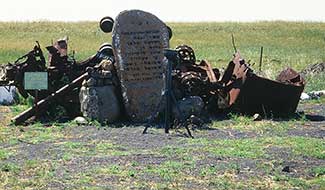 After lunch, we drove north again through the Golan Heights area. It is a lot like Colorado—lush green grass and snow-covered mountains in the distance. Unlike Colorado, there were rusted tanks and jeeps all over, left as memorials after the 1973 war.
After lunch, we drove north again through the Golan Heights area. It is a lot like Colorado—lush green grass and snow-covered mountains in the distance. Unlike Colorado, there were rusted tanks and jeeps all over, left as memorials after the 1973 war.
We tried to go through northern Galilee to the coast but were turned back. The roads were closed for military reasons. We returned and camped near the Sea of Galilee again.
It's obvious that this country is not at peace. The first thing we noticed in Tel Aviv was the number of people, especially young people, walking around with submachine guns. Soldiers take them along wherever they go, on duty or off. We picked up a couple of hitchhikers with Uzis. "Pardon our guns," said one soldier politely. "The Arabs don't like us."
Someone has a gun whenever there are groups of children, such as on school field trips. We saw tourists in shorts and T-shirts, carrying cameras and submachine guns. We've read and heard of riots and disturbances but for us, all has been peaceful. Still, there is an underlying tension and a feeling that nothing is settled, that people are waiting anxiously to see what will happen.
Today we will drive through Nazareth and on to Akko, the old Crusader port. Then north to the border with Lebanon and the beautiful sea grottos of Rosh HaNikra. We'll return to Tel Aviv and try to contact an Israeli couple we met in Amsterdam. Our ferry to Greece leaves late Sunday.
Only a little more than a week and we'll return to the U.S. It's hard to believe eight and a half months have passed. This has been a great trip and part of me wants to continue traveling. Hopefully, teaching in a new school under a new superintendent will be better and I'll be satisfied to settle down.
You're in my thoughts and prayers, Grandma and Grandpa. I can't wait to see you again!
Note: For more photos and stories from this and a later trip to Israel, read Travels to Israel.
Go on to First Observations
on Returning to the United States
Source: www.SusanCAnthony.com, ©Susan C. Anthony
